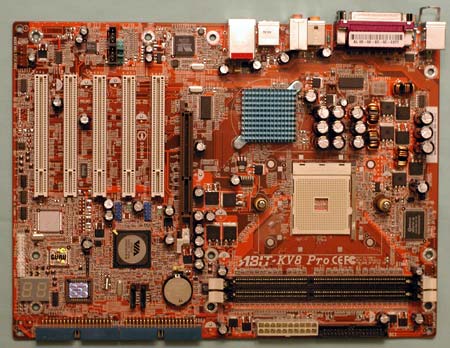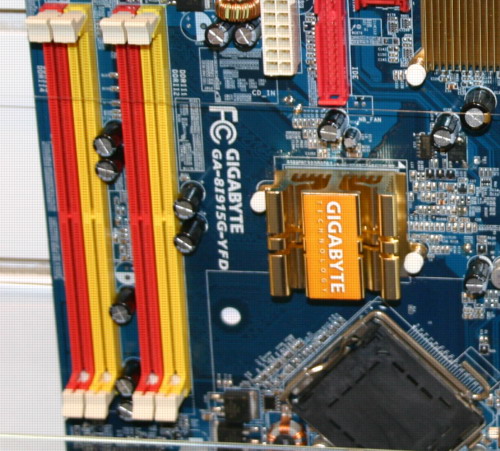Computex 2004: BTX at the Show
by Anand Lal Shimpi on June 2, 2004 7:17 AM EST- Posted in
- Trade Shows
Why everyone hates BTX
For the past several IDFs Intel has been pushing BTX (Balanced Technology eXtended) as the logical successor to ATX. Boasting a brand new layout along with new power supply specifications and new connector specifications, BTX is new, exciting and...experiencing quite a bit of backlash from the community.
Most critics of BTX seem to view it as a workaround to Intel's heat "problem" with their CPUs. More specifically, Prescott is a very hot CPU and is Intel's pushing of the BTX standard merely a way of making up for producing very hot microprocessors?
There's also the issue of heavy investments in ATX. Switching CPU sockets is one thing, but force people to buy all new cases, power supplies and motherboards and you're bound to get some negative response. Needless to say, since virtually everyone today is an ATX owner, the thought (and expense) of moving to BTX isn't exactly desirable.
Unlike most transitions we see in this industry, the move to BTX won't be an aggressive one. Granted you'll see newer systems shipping with BTX platforms, but as is very evident by the showing at Computex, the vast, vast majority of produced in the next year will continue to be ATX. As we've reported in our earlier coverage, there were only two BTX motherboards shown off at the show floor at Computex - not exactly signs of an overwhelming technology push. To Intel's credit, pushing for a brand new form factor is mostly like pulling teeth...underwater, with tweezers - it's not easy.
There are other complaints about BTX, one major one being that Intel seems to be the only one interested in pushing it, which further supports the conspiracy theory that it's just a way to deal with their extremely hot processors. One possible limitation is that BTX's layout isn't exactly very friendly to AMD's on-die memory controller; look at the picture below of a BTX motherboard and note the difficulty in running equal length traces from the CPU to the memory banks. It's not impossible and there are companies that have developed methods around trace length matching that could come in handy here, but needless to say that no AMD motherboard manufacturer is too eager to design an Athlon 64 BTX motherboard at this point. It will most likely require AMD's engineering intervention to develop a properly laid out BTX motherboard for Athlon 64 before we start seeing platforms, and with Intel driving the standard it is highly unlikely that AMD is going to be a champion of it this early in the game. After all, although AMD can benefit from a cooler running platform, they are in much less need of it than Intel at this point; plus, why not make Intel's job as hard as possible? It's only fair.

Note the direct path from the CPU to the memory banks on this Athlon 64 motherboard

BTX requires the CPU to be at the "front" of the motherboard, with the chipset behind it. Without moving the CPU to the middle of the motherboard, BTX provides some interesting challenges for AMD's on-die memory controller. A direct, equal length path to the memory banks is much easier to implement than this sort of a layout.
With all of the negativity and complaints aside, like it or not, BTX is coming and it will bring a lot of positives with it. Smaller form factors (although not as small as the ones championed by Shuttle), cooler internals and quieter overall systems are all benefits that cannot be ignored. Intel has put in a significant amount of engineering work into designing BTX and we do believe that it has the potential to deliver on its promises once designs hit the market. But the real question is when? We just mentioned that the transition will be a slow one, but in order to ease the fears of the market Intel managed to round up a bunch of BTX motherboards and display them at their showcase here at Computex. What's interesting is that these boards weren't shown off at the individual manufacturer's booths for the most part, indicating that they are not exactly top priority for these manufacturers. That being said, the board designs were available for us (read: our camera) and thus we bring you some of the very first BTX motherboards from ASUS, Gigabyte, MSI and more...










28 Comments
View All Comments
srg - Thursday, June 3, 2004 - link
Another thing, there are hardly any expansion slots compaired to ATX, I don't care about these tiny systems, I want expansion.srg
Kai920 - Thursday, June 3, 2004 - link
#9,YES! Those new Shuttles have me droooling all over. I'm waiting for the new SN95 (AMD 939) in a G5 chassis... estimate waiting time would be another year from now before prices fall to my desired levels.
tfranzese - Thursday, June 3, 2004 - link
#15, BTX has no relavence to going smaller and quieter. It's biggest benefit is cooling and even then you can reap much of the benefits by just having things rearranged in an ATX case as demonstrated by Lian-Li.Xentropy - Thursday, June 3, 2004 - link
Wow. I've never seen so much opposition to smaller, cooler cases. As a regular LAN gamer and overclocking enthusiest, both changes are quite welcome to me.I generally build a system every year, and generally buy a new case each time anyway. That said, I'm set to build out a system in a couple of months now, but it probably won't be BTX thanks to a dearth of availability. However, I'm hoping it catches on so my 2005 system can be smaller, lighter, quieter, and more overclockable.
Other than having to buy a new case to enjoy these benefits (and even if there were a smaller ATX design, you'd STILL need to buy a case for it to be smaller...what are they going to do, sell you a shrink ray to make your existing case smaller?) I see no drawbacks to the new design. And no one's forcing anyone to buy anything; it's just the smart way to go for a NEW purchase--or will be when they're available. I'm sure ATX isn't going to vanish the moment BTX starts being mass-produced. You can even still find AT cases and power supplies pretty easily years after that standard became ancient.
The arguments that this isn't "necessary" for an AMD system are silly. It isn't *necessary* for an Intel one, either; it's just better. And it would even be better for an AMD system. If you overclock, you'd get a few more speed steps or a lower Vcore; if not, you'd get a cooler case ambient temperature and longer theoretical system life.
I'm sure the trace length issue will be solved; I only hope it won't involve AMD designing *another* spec (CTX?) and causing even more of a stir. In a perfect world, AMD and Intel would actually sit on a panel *together* to design this sort of thing (we have standards committees for everything else, why not motherboard and case layout?) and we'd get a design that was both friendly to on-die memory control *and* allowed for another few degrees cooler computing and a few pounds shaved off that hunk of metal I have to sling over my shoulder now and then. Alas, the world isn't perfect, so one of them has to step up and be the "bad guy" and try to improve technology. Of course, if AMD were doing it they wouldn't be bad at all; it would suddenly be the best thing since 64-bit. The "underdog" psychological phenomenon is an interesting one.
tfranzese - Wednesday, June 2, 2004 - link
Lian-Li has the best option IMO. An ATX case with zones much like the BTX and mac case layouts.StrangerGuy - Wednesday, June 2, 2004 - link
Just like the 9xx chipsets. No AGP? Only PCI-E? I was like thinking WTF. Many of us here have quite a lot money spent on our AGP cards, and many of these cards are 9700/9800/5900/X800s which is still very capable for the time being.Even if Intel needed to push PCI-E, at the very least give us a transitionary product so we can keep our AGP cards and upgrade to a PCI-E one some time later.
But now Intel wants us abandon our ATX casings, motherboards, AGP video cards if we wanted a Intel-based CPU upgrade just for this silly BTX spec, which the advantages still remain unproven. Result? Almost everyone
flock to A64s or AXPs. Bottom line? Less people buy Intel.
epiv - Wednesday, June 2, 2004 - link
Can Intel just improve the ATX standard or create a new standard competible with ATX? I beleive it is possible to design a new standard that have all the benefit of BTX and still competitlbe with ATX.Intel loves to ignore other people's investment. They have failed many time for this reason. For example, Rambus which is a lot more expensive than DDR because memory manufacturer cannot use exist equipement to produce and test Rambus memory. Also Itanium which cannot rum 32 bit program well which most company invest a lot money on.
sprockkets - Wednesday, June 2, 2004 - link
The ATX standard has been around since 1997 or so. Remember that with the AT standard there was no real i/o ports, and most of the stuff was in front of the pci/isa slots. And the power button was not full logic either. That right there was a nice improvement: Having computers with the ability to turn on and off without pushing buttons.shabby - Wednesday, June 2, 2004 - link
4 of the mobo's pictures have the power connecter above the x16 slot.... whose idea was that?!?Zak - Wednesday, June 2, 2004 - link
Two intake fans at the side next to PCI and AGP and one exhaust at the very top helps to relive the PCI/AGP/CPU heat buidup in an ATX case. Plus if there are two 8mm fans on the back, as in Chieftec cases, it helps. Sure it can get noisy if you pick lousy/cheap fans.Zak